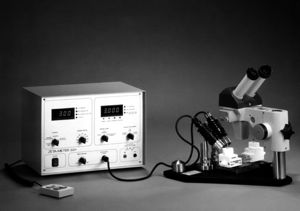Zeta Meters
Zeta Meter is used to understand and control colloidal suspensions, emulsions and slurries.Zeta-meter is designed to tackle all the problems encountered when measuring the electrophoretic mobilities and calculation of the Zeta Potential of colloidal suspensions.
Laser illumination and video interface allows submicronic particle measurement.Besides, it can also be used with both aqueous and organic suspending liquids. By using this system, a complete run takes only minutes and a single tracking takes seconds.
Made using a technique called microelectrophoresis, Zeta potential measurement system has a high quality stereoscopic microscope for comfortably observing colloidal particles inside a chamber called an electrophoresis cell. Placed in each end of the chamber, electrodes are connected to the Zeta Meter , which creates an electric field across the chamber. Velocity and direction are related to their zeta potential that enables the charged colloids to move in the field.For using the instrument, the user needs to fill the cell with the sample, insert electrodes, place it under the microscope and connect them to the Zeta-Meter . By helping to select the appropriate voltage to apply, zeta meter determines the specific conductance of the sample. Once the electrodes get energized, colloids move across a grid in our microscope eyepiece. For ease of viewing, optional video display can be connected with it. By simply pressing a track button and holding it down, the user can track the colloid traversing the grid. The zeta meter instantly calculates and displays the colloid's zeta potential , when the track button is released.User can review at any time a record of the measurements, which the zeta-meter constantly maintains. When the status button is pressed, user can view the number of colloids tracked, their average zeta potential and the statistical standard deviation of the values.
Applications
- ceramics
- isoelectric point
- polymer latex
- nanoparticles
- emulsions
- micro-emulsions
- liposomes
- water treatment
- papermaking
- clays
- pigments
- flotation
- biology
- immunology
